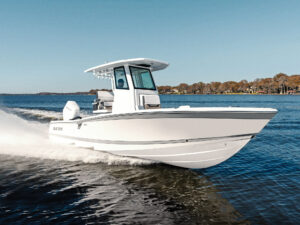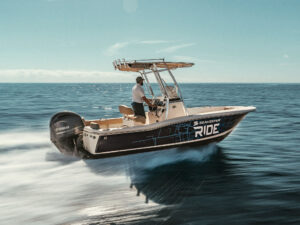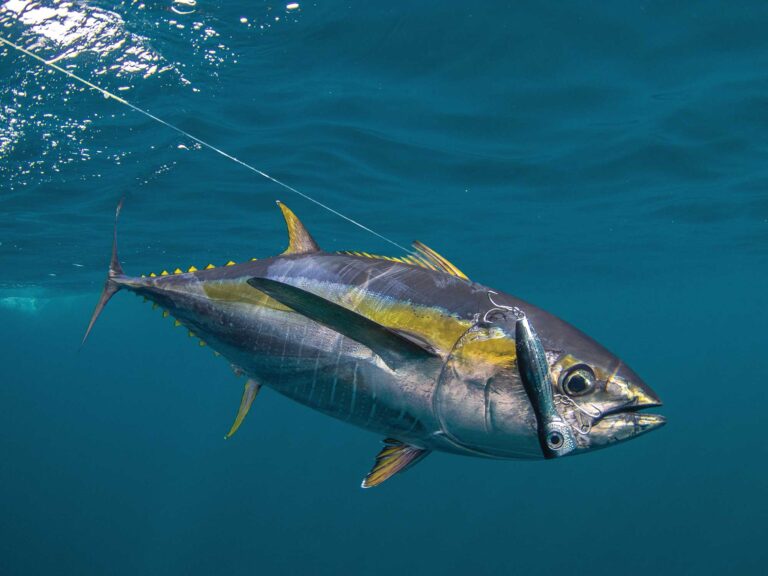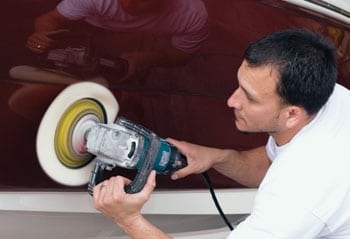
There are good reasons why Navy boatswain’s mates spend so much time chipping, painting and polishing their ships. In the harsh saltwater environment, little problems can turn into big ones in a hurry. Clean, smooth hulls offer less resistance in the water. Less resistance means more speed and better fuel efficiency. Routine cleaning also keeps the ship combat-ready and prolongs its life span.
The same benefits apply to sport-fishing boats. Regular cleaning and maintenance increases dependability and performance. It also helps preserve the boat’s resale or trade-in value. And right now – after the shrink-wrap comes off, and before the fishing gets hot – is the best time to get back into the cleaning routine.
“The older the boat, the more porous gelcoat gets,” says Jim Christenson of 3M Products. “Stains become harder to remove as they penetrate into the pores. Oxidation is another common problem. It’s caused when the gelcoat or the outer layer of polyester resin is damaged by ultraviolet light, air pollution, exhaust or dust. Salt crystals magnify the sun’s rays and accelerate the UV effects. If your boat’s surface is flaky, chalky or noticeably uneven, you’ve got oxidation. Fortunately, a three-step process of compounding, polishing and waxing will make your boat look like new again,” the 22-year industry veteran explains.
Getting Started
Before tackling oxidation, Christenson recommends washing the boat to remove any existing dirt. The next step is choosing the right buffing agent. Heavy oxidation requires aggressive compounds, but some, like the heavy-duty brown paste designed originally for lacquer paints, might actually stain white gelcoat. It’s better to start with a milder formula first to see if it will do the job before going more aggressive. Imperial compounds are usually adequate for moderate oxidation and are specifically designed for darker gelcoats and color restoration.
Apply the compound by hand or with an orbital buffer set to 2,200 rpm or slower. The slower speed reduces slinging and lets the compound’s abrasive particles work. Move forward in small sections no more than a shoulder width apart. Wear eye protection and avoid loose clothing or jewelry when using power tools. A chair or stool increases the comfort level. Christenson and other pros use wool buff pads to remove the damaged layers. Make sure the buffer pad stays flat against the boat’s surface to prevent deep swirl marks. If possible, work in the shade to keep the compound moist, and change the applicator pad often. A circular motion or X pattern will overlap swirl marks and reduce finish work.
“Don’t do too big an area at one time,” Christenson cautions. “If you do, the compound or wax will dry out, making it harder to remove. Make sure you have good lighting, and inspect your work by looking at an angle rather than straight on to spot the swirl marks.”
For oxidized or faded dark-colored hulls, Matt Winchell of Winchell Marine in Wilmington, North Carolina, often uses wet sandpaper to restore the boat’s finish. He starts with 800-grit paper before switching to the finer 1,200 grit. Paper is changed often to prevent residue loading.
Sanding
“The safest and best way to sand is by hand,” Winchell explains. “Electric sanders are too fast, and even with air sanders, it’s easy to screw up. Sand at diagonal angles, and cross back over in a hatch pattern to remove any grooves. Take your time, and go slow. Afterwards, use a polishing glaze with a foam applicator pad to remove any swirl marks.”
Winchell says he also uses polishing compounds and a soft, dry pad to remove minor scratches from vinyl weather enclosures. For varnished teak or other wooden trim pieces, he swears by Bristol epoxy coating. “You can apply multiple coats in a day or two rather than a week, and it lasts a couple years in the tropics,” he explains. “Traditional varnish only has about a six-month life span.”
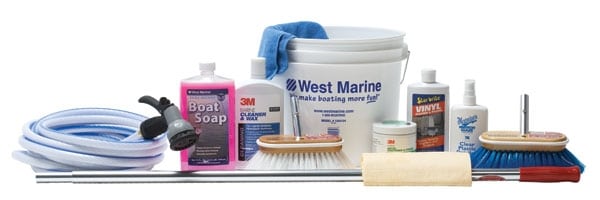
It will typically take a full weekend (12 to 16 hours) of work to buff and detail an oxidized 25-foot center console, Winchell says. Professionals charge $30 to $35 a linear foot, on the average. Mike Register, who owns Mike’s Marine Ways in St. Marks, Florida, details at least one boat a week.”Spring is our busiest time of year, obviously, but detailing is a regular part of my business,” Register explains. “Whether you do it yourself or we do it, the best protection afterwards is a good wax job. I like a cleaning wax with carnuba, like Meguiars. If you don’t use harsh detergent soaps and you wax again whenever the water quits beading, that’s the best protection against oxidation.”
There are a number of effective marine cleaning products available, including 3M, Meguiars, Star Brite and house brands from Boater’s World and West Marine. Use each for its intended purpose, however.
“There’s no such thing as a universal cleaner,” Christenson explains. “Leave the household products under the sink, and avoid harsh chemicals like acetone, stain removers with acid, or toilet bowl cleaners. They’ll just remove the wax and damage the gelcoat. With the right compound and a little elbow grease, you can take care of any stains or problem areas.”
Take the time now to have your boat cleaned and waxed. That way, it’ll be ready for more important things later on, like helping you catch more fish.
Basic Cleaning Kit
- Nonmarking water hose and nozzle
- Telescoping brush handle
- Boat soap ? Cleaner wax for touch-ups
- Microfiber cloth or mitt
- Stiff bristle brush (white) for decks and nonskid
- Bucket
- Chamois
- Metal polish
- Vinyl cleaner
- Soft bristle brush (blue or yellow) for smooth surfaces

